Ewart Oakeshott: The Man and his Legacy: Part IV
An article by Chad Arnow,
Russ Ellis,
Patrick Kelly,
Nathan Robinson, and
Sean A. Flynt
Compiled and produced by Nathan Robinson
Page 4 of 5 — Go to: Prev 1 2 3 4 5 Next
Cross-guards, which separate the grip from the blade, were grouped into a dozen basic styles and are symbolized by Arabic numerals (1-12). These styles, too, showed a near-boundless amount of variety and decoration. We find a letter following the number if showing a sub-category of the same family. (For example: Style 1a)
Style 1 |
Style 2 |
Style 3 |
Style 4 |
Style 5 |
Style 6 |
Style 7 |
Style 8 |
Style 9 |
Style 10 |
Style 11 |
Style 12
| Style 1 |
Style 2 |
Style 3 |

One of the simplest forms, this cross is simply a straight bar of metal which is tapered towards the ends. This is the famous "Gaddhjalt" (spike hilt) form which was in constant use from the Viking era through the 17th century. Cross-section is usually square but can be circular or even octagonal. Style 1a is a simplified form, being only a straight rod—square, circular, or octagonal—widening at the center to accommodate the tang.
|

This style is slightly more complex than Style 1. Each of its straight arms is "waisted" and flares back to its original width at its terminal. Most notable examples date from the 15th century but earlier examples do exist.
|
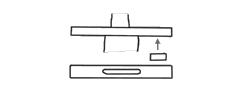
This style consists of a relatively short, rectangular-sectioned bar. This style enjoyed periods of popularity first in the 12th and 13th centuries (1150-1250) and then again in the 14th and 15th centuries (1380-1430).
|
|
| Style 4 |
Style 5 |
Style 6 |

This, again, is a fairly simple style consisting of a straight cross with its terminals bent toward the blade. Many examples of this style are found on swords of the 12th century but it is not confined to this era and can be found as late as the 15th century and as early as the 10th. Cross-section is square or round.
|
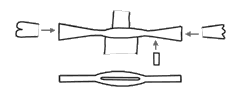
This style is popularly known as the "bow tie" style due to its widened and flattened terminals. This type is often heavily embellished and found on the great swords of Type XIIIa and Type XIIIb although it is not confined to those types. This style was popular in the 13th and 14th centuries.
|

Style 6 is can be thought of as a sort of curved or bent Style 5. The flattened terminals are more pronounced on the side of the cross closest to the blade. The same sorts of embellishment found on the Style 5 crosses are also found on crosses of Style 6. This style was also popular in the late 13th century through the 14th century.
|
|
| Style 7 |
Style 8 |
Style 9 |
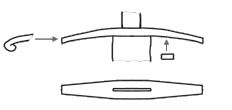
This style consists of a broad flat section (when viewed from the point or from the pommel) that is curved toward the blade. This style seems to have been popular mostly during the 14th century.
|

At first glance, Style 8 may be mistaken for a Style 4 in that it is a straight cross which has had the terminals bent towards the blade. However, it is a significantly more sophisticated type of hexagonal cross-section instead of square or round like Style 4. It also has a pronounced écusson where Style 4 usually has none. This style was popular in the 14th and 15th centuries.
|
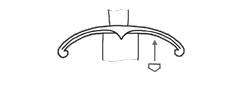
This is one of the more complicated styles to correctly make. Style 9 has a wide, flat cross-section similar to a Style 7, but it terminals are rolled over and even more dramatically bent towards the blade and the terminals are rolled over. The cross-section is also complicated, being a flattened diamond shape or else flat on top with a V-shape underneath. This style also has a pronounced écusson. Most examples are from the 14th or 15th centuries.
|
|
| Style 10 |
Style 11 |
Style 12 |
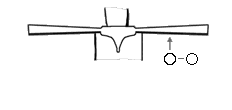
This is another straight style, but is more complex because its arms taper towards the sword rather then away from it. This type has a pronounced écusson. This style was popular in the 15th and 16th centuries.
|

Style 11 is chiefly characterized by its prominent knobbed terminals and circular or rhomboid cross-section. This is a later type popular mostly during the 15th and 16th centuries.
|
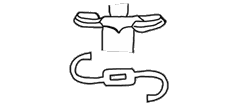
Style 12 is another complex style. Its arms are curved strongly in opposite directions in the horizontal plane causing it to be S-shaped when viewed from the pommel. Cross-section can be round, rhomboidal, hexagonal, or octagonal. This style also seems to have been popular in the 15th and 16th centuries.
|
|
Grip Styles
There is one last component of medieval swords that can be used to aid in its identification. While it did not receive its own lettered or numbered typology, Oakeshott did discuss it at great length near the end of The Sword in the Age of Chivalry. Grips were most often made of organic materials (leather, horn, bone, and/or wood) and so have not always survived the ravages of age. When they do survive, though, they can be an important indicator in a sword's identification and date, since they were so influenced by fashion. Two construction methods seem to have been predominant.
| Sandwich Method |
Bored-through Method |
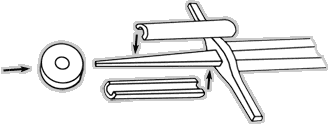
This grip is made in two halves carved to fit the tang. Grips of this form are generally present when the sword's tang is broad and flat, and were in popular use from the Viking Age through the 12th century (though isolated examples are found later). They are most often of a flattened oval cross-section and taper gradually to the pommel.
|

This method is more complex and better suited to tangs that were "stalk-like," as Oakeshott put it; longer and more slender. In this method, the grip is shaped and then is bored straight through. The tang is then heated and the grip is forced down onto it, causing a perfectly shaped recess to be burned out of the wooden core. Grips of this type were generally much more rounded, often being of circular or hexagonal shape.
|
|
The different types of grip construction can be loosely divided, with considerable overlap and exception, the same way Oakeshott divided swords: Swords of Group I (Type X through Type XIV) often were equipped with a "sandwich" grip, while swords of Group II (Type XV through Type XXII) generally saw the bored-through method of construction.
Oakeshott defined eight common forms of grip shape, but noted that an extreme amount of variety existed both in their details and the material used to cover them.

|
|
Swords generally of Group I
|
Swords generally of Group II
|
The materials used to create grips varied as widely as did blades, guards, and pommels during the heyday of the Medieval sword. They were typically made of a hard core of wood, bone, or horn. Many grips were finished only with a simple covering of leather, vellum, or fabric and were often adorned with a binding of cord or wire. Examples have been found with grips of bare wood or horn, though. After the 13th century, these simple grip treatments continued but the practice of using more complex treatments became more common. When wire was used, it seems to have always been twisted and made up of multiple strands. When grips were bound with cord, they often were covered with thin leather such as kid or doeskin, allowing the pattern of the under-cord to still be visible.
The 15th century saw long, dual-shaped or two-piece grips. These were often of the "bored-through" construction method. Many saw each half covered differently, having the lower portion covered with leather while the upper was bound with wire, as one example.
It's important to note that a sword may have seen many changes to its grip or its grip covering, often having it replaced or modified several times during its working life. Grip styles changed drastically with the fashions of the time, and so caution must be used when attempting to use the grip to firmly date a sword.
 Continue to Part 5 Continue to Part 5
Sources
Archaeology of Weapons: Arms and Armour from Prehistory to the Age of Chivalry, The, by R. Ewart Oakeshott
Sword in the Age of Chivalry, The, by R. Ewart Oakeshott
Records of the Medieval Sword, by R. Ewart Oakeshott
European Weapons and Armour: From the Renaissance to the Industrial Revolution, by R. Ewart Oakeshott
Sword in Hand: A History of the Medieval Sword, by R. Ewart Oakeshott
Acknowledgements
Most of the accompanying text written by Chad Arnow
Typology in Detail table data and the pommel/cross descriptions supplied by Russ Ellis
Typology illustration created by Nathan Robinson and based on the work of Ewart Oakeshott
Sword line drawings created by Nathan Robinson, based on swords from Records of the Medieval Sword
Pommel, cross, grip, and sword family line drawings created by Nathan Robinson, based on the work of Ewart Oakeshott
List of published works created by Patrick Kelly
Contributions and fact checking provided by Craig Johnson of The Oakeshott Institute
Editing tasks provided by Nathan Robinson, Chad Arnow, and Sean Flynt
Production services provided by Nathan Robinson
Additional Information
Please see our Spotlight Articles on each Oakeshott sword type:
Type X, Type XI, Type XII, Type XIII, Type XIV, Type XV, Type XVI, Type XVII, Type XVIII, Type XIX, Type XX, Type XXI and XXII
|
|